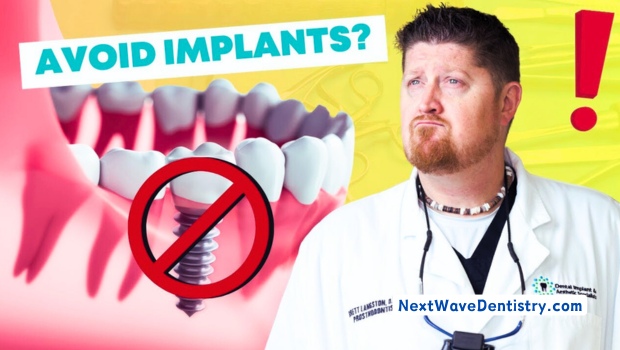Dental implants can transform your smile, but are they the right choice for everyone? Dr. Brett Langston breaks down the key considerations for determining implant suitability, from health prerequisites to lifestyle habits. Discover if you’re a good candidate for this life-changing procedure.
Understanding Dental Implants: The Basics
Dental implants have revolutionized modern dentistry, providing a reliable solution for those missing teeth. But, what exactly entails implant dentistry, and is it suitable for everyone?
What Are Dental Implants?
Implants are essentially titanium screws strategically placed into the jawbone. This high-strength material functions as a stable base for artificial teeth. But the process involves more than just placing a screw.
Replacing Teeth: One or Many?
The implants serve to replace a single tooth, several teeth, or even a whole arch. Isn’t that amazing? But they aren’t a one-size-fits-all solution.
Osseointegration: The Bone Bonding Process
For the implant to hold successfully, it must undergo osseointegration. This is when the bone cells grow around the implant, essentially making it a part of your anatomy.
And here’s the kicker: this healing process spans from 3 to 4 months. During this period, patience is indeed a virtue.
Building Teeth on Top
Once the healing period is over, the exciting phase begins. This is when they start building teeth on top of the implant. The meticulously crafted prosthesis provides not just function, but also a natural appearance.
Are You a Potential Candidate?
Isn’t it fascinating that not everyone is eligible for dental implants? Potential candidates might need to view informative content regarding candidacy, as certain requirements need to be met.
- Healthy Bone: It’s crucial. The implants need an adequate amount of strong bone for support.
- General Health: Conditions like uncontrolled diabetes can hinder the healing process.
Preparation and Information
Like a strategic chess game, knowing your moves is crucial. Engaging in comprehensive learning through videos or consultations could be a game-changer for many potential candidates.
“For implants to be successful, basically you have to have two things. You have to have a healthy patient with a healthy mouth, and you have to have adequate bone.” – Dr. Brett Langston, Prosthodontist
Now, when reviewing your oral health strategy, understanding these basic tenets of dental implants could set you on a path to a healthier, more confident smile.
Candidacy for Dental Implants
For individuals considering dental implants, determining candidacy is essential. Dental implants, which are essentially titanium screws that integrate into the jawbone, offer a durable solution for replacing missing teeth. However, there are several key factors that determine whether an individual is a suitable candidate for this procedure. Understanding these factors can help prepare anyone considering implants for a successful outcome.
1. Healthy Patients Are Prime Candidates
A healthy patient is at the forefront of candidacy for dental implants. Being in good overall health ensures the best possible recovery and healing post-surgery. But what does “healthy” mean in this context? Primarily, it refers to an absence of chronic conditions that might impede healing. Dental surgeon, Dr. Brett Langston, notes, “For implants to be successful, you must have a healthy patient with a healthy mouth.”
2. Bone Quantity and Quality Are Critical
The condition of the jawbone is a crucial factor. Both the quality and the quantity of bone need to be adequate to support the implant. If the ridge of the jaw is too thin or the bone insufficient, the implant might not only fail but also compromise the bone’s integrity. Thankfully, techniques like bone grafting and augmentation can enhance bone volume when needed.
3. Uncontrolled Diabetes Poses a Risk
Uncontrolled diabetes is a significant red flag for dental implants. The condition negatively affects the body’s ability to heal, which is essential for the integration of the implant into the bone. Without proper healing, the success of the implant remains dubious. Thus, managing blood sugar levels is crucial for those with diabetes.
4. Bone Growth Medications Impact Healing
Interestingly, medications that promote bone growth, such as Fosamax and Boniva, can complicate the implant process. These medications might interfere with bone healing around the implant, and it is vital to discuss their use during consultation.
5. Health Assessment Includes 3D Scans
Modern technology plays a significant role in assessing candidacy. A 3D cone beam scan provides comprehensive details on bone structure, aiding in precise surgical planning. This scan allows dentists to virtually place implants, ensuring optimal outcomes by visualizing surrounding teeth and tissues.
6. Consultation is Key to Success
Engaging in a thorough consultation is imperative. This dialogue not only allows professionals, like Dr. Brett Langston, to evaluate the physical aspects of candidacy but also aligns patient goals with feasible options. This bespoke planning phase guarantees that both the patient and the practitioner are on the same page, paving the way for successful implant placement.
Assessing candidacy for dental implants is a meticulous process that should involve both medical and personal considerations. For those eligible, the journey towards a restored smile begins with a simple conversation.
Impact of Lifestyle Choices on Implant Success
Challenges Faced by Smokers
Despite the advancements in dental technology, smokers face additional challenges when it comes to the success of dental implants. Why is that? Smoking introduces harmful chemicals into the mouth, creating an environment that’s less than ideal for healing.
The heat and toxins from tobacco can disrupt blood circulation, crucial for the healing process. This impairs the body’s ability to accept and integrate the implant securely into the bone. Imagine trying to plant a tree in rocky, infertile soil. It’s similar, right?
The Negative Role of Tobacco
Tobacco affects healing, and more importantly, *bone integration*. Osseointegration, the process where bone cells grow onto the implant’s surface, is impeded. Dr. Brett Langston, a leading prosthodontist, emphasizes, “The chemicals and carcinogens in cigarettes can really damage the mouth, not allowing it to heal the way we want.”
Cessation Aids and Mitigating Risks
Are smokers doomed to fail with implants? Not necessarily. Cessation aids like nicotine patches can help mitigate these risks. They provide a pathway for smokers to gradually reduce dependence, promoting a healthier environment for implant success.
- Nicotine patches
- Support groups
- Medications
Optimal Healing Sites for Success
Successful implants require sites that promote ideal healing. Just as you wouldn’t build a house on shifting sands, an implant needs stable, healthy bone to thrive. This means ensuring the bone is strong and dense enough to support the implant long-term.
The Power of Motivation
Motivation to quit smoking enhances outcomes, as many patients find the journey to quitting beneficial in unexpected ways. Dr. Langston points out, “I’ve had a lot of patients use getting an implant as a reason to finally quit smoking.”
“They do the implant, stop smoking for six weeks, and realize—it’s great! I’m saving money and feel better.”
Engaging in Cessation Discussions
Engaging in cessation discussions is pivotal. Dentists can play a transformative role, providing both supplements and emotional support. It’s about fostering a relationship where the patient feels equipped to make healthful changes. Considering an implant as an incentive to quit could be the motivation one needs to embark on a healthier lifestyle.
Needless to say, a supportive dialogue can be just as important as the technical details of implant placement itself.
Age Considerations: Too Young, Too Old?
When considering dental implants, age often becomes a pivotal point of discussion. But what does age really mean in terms of eligibility for implants? Let’s dive into this complex subject to unravel the specifics.
Older Patients
Age isn’t merely a number when it comes to dental health. Particularly for older individuals, if health is maintained, age does not necessarily serve as a barrier. With the right health parameters and robust bone structure, older patients can indeed succeed with implants. There have been cases of implants in patients well into their 90s, as long as their health and bone condition support it.
Why No Upper Age Limit?
- Strong Bone Structure: A healthy and sufficient amount of bone is essential for osseointegration, the process where the bone and implant bond.
- Good Health: A healthy mouth and overall health vastly improve the chances of successful healing.
In contrast, younger patients face a different dilemma.
Younger Patients: Challenges and Considerations
Younger patients, despite their generally good health, deal with another issue—uncertainty in bone growth. For females under 21 and males under 25, caution is exercised. Is your bone done growing? Not always. The bone could change after implant placement, potentially leading to issues down the line.
Why the caution? Here’s why:
- Continuous Growth: An implant placed too early can become misaligned as the surrounding bone continues to develop.
- Potential Complications: Correcting such issues later can be invasive and complex.
Hence, waiting for these age limits ensures a higher likelihood of long-term success. But what are the alternatives during this waiting period?
Alternative Solutions for Young Patients
- Resin Bonded Bridges: A temporary yet effective method to fill missing teeth spaces.
- Removable Appliances: Easily adjustable as the bone structure stabilizes over time.
Such alternatives provide functional and aesthetic solutions without compromising future implant success. It’s about playing the long game.
After all, impatience can lead to more problems than solutions when it comes to implants.
Ultimately, whether you’re considering implants now or later, the key is thorough consultation. An experienced dentist evaluates your unique situation, guiding you towards the best choice for your age and health, harmonizing science and care.
Alternative Solutions for Dental Concerns
Isn’t it frustrating when a dental issue holds you back? Missing teeth can significantly impact one’s confidence and oral health. Solutions abound, though. With technology and modern dentistry, temporary solutions can bridge the gap—pun intended—until you’re ready for something more permanent.
Temporary Solutions for Missing Teeth
- Bridges: These are pseudo-teeth that fill in the blanks. They attach to adjacent teeth, giving you a near-natural appearance.
- Appliances: Think removable partial dentures. Handy, functional, and significantly more affordable than implants.
These fixes offer a temporary reprieve, allowing you to smile without hesitation. Why endure an unwanted gap if you don’t have to?
Camouflage Techniques Until Bone Maturity
For younger folks, bone maturity dictates timing. For instance, a single implant might seem perfect, but if you’re under 21 and still growing, it could lead to future complications. Hence, camouflage methods such as resin-bonded bridges remain vital. They serve well until the bone reaches full maturity.
Minimizing Invasive Procedures Later
Early interventions can sometimes save you from costly and invasive surgeries later on. Imagine a scenario where a patient doesn’t wait for full bone maturity, leading to complications. No one wants unnecessary procedures, right?
Consultation: The Key to Interim Solutions
Individuals are unique, and so are their dental needs. Consulting with a dental professional helps determine the best interim solution tailored for you. Doctor Brett Langston, a seasoned prosthodontist, emphasizes how vital consultation is to outline potential strategies—”Just because you’re missing a tooth, doesn’t mean you need an implant.” The right advice can save future headaches.
The Timing of Implants: A Crucial Decision
Time is of the essence. For dental implants, timing is crucial. Doctor Langston points out, “While the upper age limit is flexible, the lower bound requires caution due to growth concerns.” Evaluating these factors beforehand ensures successful outcomes.
Explore All Dental Options Before Committing
Before diving into a permanent solution, exploring various dental options is essential. Did you know that implants aren’t always the answer? Other methods like natural bridges or removable appliances might suit you better.
“For an implant to be successful, we want to create that ideal site, that ideal area where the body can make it successful.” – Doctor Brett Langston
This wealth of alternatives ensures everyone can find a solution tailored to their unique situation. So, what’s your next move?
The Role of Dental Hygiene in Implant Longevity
Why Good Hygiene is Critical for Implant Success
Dental implants might seem like a permanent solution with minimal maintenance, but that’s a myth. Just like natural teeth, implants require diligent care to thrive. Without proper dental hygiene, implants can fail. But why is this the case? Simply put, bacteria have no favourites. They attack implants the same way they attack natural teeth, leading to potential complications.
Regular Cleaning: Even Implants Aren’t Immune
Some people believe that implants create an “immune” zone, free from decay. Sounds convenient, right? Yet, reality paints a different picture. Even implants need regular cleaning. Without it, they can suffer from plaque buildup. Over time, this could be disastrous. It’s akin to skipping oil changes in a brand-new car. You just wouldn’t do it.
Plaque Buildup and Bone Loss: The Hidden Dangers
Now, let’s talk about the unseen threat: *plaque buildup*. When plaque forms around an implant, it doesn’t just sit there. It spurs inflammation which can lead to bone loss. And without a sturdy bone structure, the implant may fail. To draw an analogy, it’s like building a house on shifting sands. What does this mean for implant longevity? The healthier the surrounding bone, the longer your implant lasts.
Motivation: The Key to Post-Implant Care
Maintaining implants is not just physical; it’s psychological too. Motivation is essential for post-implant care. Imagine someone invests in a precious piece of art. Naturally, they’d want to keep it pristine. Similarly, for implants, regular appointments and personal care are vital. *Are you motivated enough?*
Debunking the Myth: Implants Still Need Care
Some myths die hard, and the “carefree implant” is one of them. While implants don’t develop cavities, they demand meticulous care. Dental implants are not a free pass to relax your hygiene habits. Regular flossing and brushing are still crucial. They ensure that plaque doesn’t undermine the implant’s support structure. In short, tinkling alarms the moment you slack off.
Hygiene Discussions: A Crucial Part of Consultations
Before diving into the world of implants, patients should engage in hygiene discussions integral to consultations. Expert advice tailors individual care routines, spotlighting preventable mistakes. After all, would you embark on a journey with an obscure map? Knowledge and preparation are half the battle won.
“A lot of time with implants, you have to increase your attention to your hygiene to ensure they’re successful,” reminds Dr. Brett Langston, renowned prosthodontist.
This structured approach, peppered with rhetorical questions and emphasis, captures key points about maintaining healthy dental implants while maintaining an engaging, third-person narrative with a professional tone.
The Importance of a Personalized Consultation
Have you ever wondered why personalized consultations are crucial before any dental procedure, especially implants? The key lies in the details. Every mouth is unique, and understanding those nuances is vital to ensuring successful outcomes.
3D Scanning: A Closer Look at Individual Needs
To kick things off, 3D scanning plays an integral role in assessing individual needs. This advanced technology provides detailed images of the dental structure, allowing professionals to map out precise plans. Think of it as a blueprint for your unique dental architecture.
Evaluating Bone Structure and Adjacent Teeth
Next, evaluating the bone structure and adjacent teeth is like a thorough inspection before building on a site. Dr. Brett Langston, a prosthodontist, emphasizes, “You have to have adequate bone.” A bone’s health and positioning determine the feasibility of dental implants. Adjacent teeth should also be considered to ensure they won’t be compromised.
Discussing Long-Term Goals with the Patient
Dialogue, as simple as it sounds, shapes the direction of any treatment plan. Discussing long-term goals with patients ensures their expectations align with what’s achievable. It’s not just about what can be done now, but what will sustain health and satisfaction in the years to come.
Uncovering All Dental Possibilities
A personalized consultation isn’t just about exploring implants. It uncovers all dental possibilities. Patients might think they need one solution, but a detailed discussion often reveals surprising alternatives. Is an implant really necessary, or could other methods suffice?
Exploring Non-Implant Options
Visits also allow dentists and patients to explore non-implant options, making sure every choice is on the table. Langston provides, “There are lots of techniques to camouflage missing teeth.”
Achieving Tailored Dental Solutions
Ultimately, the goal is to achieve tailored dental solutions through dialogue. Personalized attention and a profound understanding of each patient’s unique scenario ensure the best possible outcomes.
In conclusion, a personalized consultation lays the foundation for dental success. By utilizing cutting-edge technologies like 3D scanning and engaging in open, honest conversations, providers like Dr. Langston offer solutions that truly fit. It’s more than just addressing the current issue; it’s about paving the way for a healthier, more confident future.






